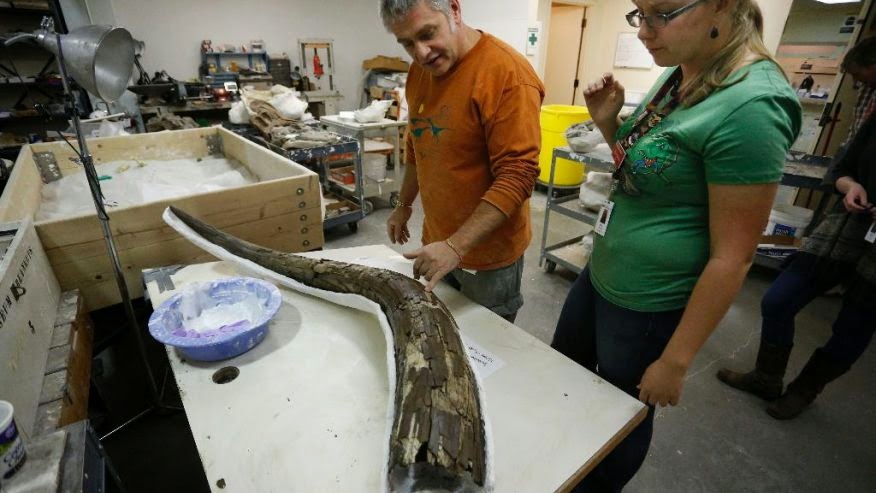Among their findings: The warmer weather allowed forests to reach about 2,500 feet farther up the mountainside than today's tree line, which is about 11,500 feet above sea level at the Snowmass site. Forests also may have been denser, and smaller trees and grasslands might have been more widespread amid drier conditions.
A team of 47 scientists has been studying material unearthed four years ago near Snowmass, a town just outside Aspen, when a bulldozer was enlarging a reservoir. The researchers published their first big batch of data in the journal Quaternary Research in November.
 |
| Ancient mastodon bones sit on a shelf, part of an extensive discovery unearthed from Snowmass, Colo., inside a workroom at the Denver Museum of Nature and Science [Credit: AP/Brennan Linsley] |
"It's a beautiful record of the last time it was as warm or warmer than it is today," he said.
The information gives scientists solid data to check their climate models against.
It also means that figuring out the impacts of human-produced greenhouse gases combined with natural changes might be more complicated than previously thought. "The point is ... if we haven't seen all the natural variability in the system and we are causing warming, where are we going?" Miller said.
"It shows an example of a world that's that warm and shows us some manifest examples of how animals react to that," said Ted Scambos, lead scientist at the National Snow and Ice Data Center at the University of Colorado. "What we're headed for is kind of a different situation where we're turning the knob way up on climate in a very short period of time."
The reservoir where the bones were found was originally a natural lake and sits on a ridge about 9,000 feet above sea level. The sediment and bones provided a record of about 85,000 years, from 140,000 years ago to 55,000 years ago.
The site didn't produce any information about why animals became extinct, but it did provide hints about what their lives were like, Miller said. For example, mastodon tusks grow a little each year, producing rings like trees do, he said. The size of each ring indicates whether times were good or bad.
"When it's stressful, they grow very little, and when it's nice, they grow a lot," Miller said.
The bones are at the Denver Museum of Nature and Science and sediment samples are at a USGS site in the Denver suburb of Lakewood. Studies will likely continue for years, Miller said.
Online: Denver Museum of Nature and Science Snowmastodon Project: http://www.dmns.org/science/the-snowmastodon-project/
Author: Dan Elliott | Source: The Associated Press [November 26, 2014]








